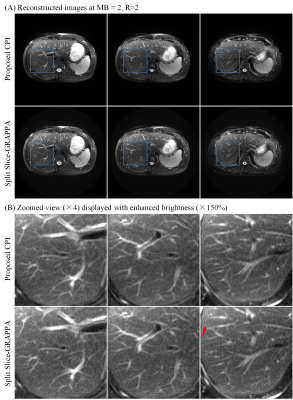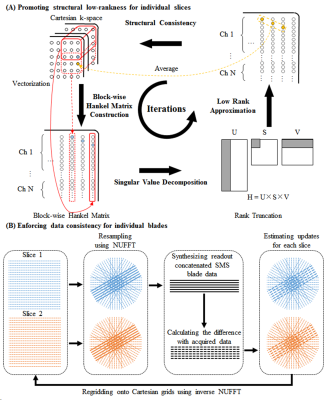Yilong Liu1,2, Kun Zhou3, Dehe Weng3, Hua Guo4, and Ed X. Wu1,2
1Laboratory of Biomedical Imaging and Signal Processing, The University of Hong Kong, Hong Kong, China, 2Department of Electrical and Electronic Engineering, The University of Hong Kong, Hong Kong, China, 3Siemens Shenzhen Magnetic Resonance Ltd, Shenzhen, China, 4Center for Biomedical Imaging Research, Department of Biomedical Engineering, Tsinghua University, Beijing, China
1Laboratory of Biomedical Imaging and Signal Processing, The University of Hong Kong, Hong Kong, China, 2Department of Electrical and Electronic Engineering, The University of Hong Kong, Hong Kong, China, 3Siemens Shenzhen Magnetic Resonance Ltd, Shenzhen, China, 4Center for Biomedical Imaging Research, Department of Biomedical Engineering, Tsinghua University, Beijing, China
The
proposed method performs simultaneously calibrationless parallel imaging (CPI)
reconstruction and blade combination. Compared to conventional split
slice-GRAPPA, it jointly reconstructs all blades, leading to improved SNR and
reduced artifacts in abdominal imaging.

Figure 4 Reconstruction for 30-channel abdominal MR data at
MB=2/R=2. Compared to SPSG, the proposed CPI results in improved SNR in both
background and abdominal regions. As shown in the zoomed view, SPSG suffered
from slight residual artifact (vertical ringing indicated by red arrow), which was
not visible in results from proposed CPI.

Figure 1 Diagram of the proposed calibrationless parallel
imaging (CPI) reconstruction. It iteratively updates the estimated k-space by
sequentially promoting structural low-rankness and enforcing data consistency.
(A) Structural low-rankness is promoted for individual slices by constructing a
block-wise Hankel matrix, performing singular value decomposition, and forcing
low-rankness through rank truncation. (B) The data consistency is enforced for
individual blades by minimizing the difference between synthesized/acquired SMS
blade data.